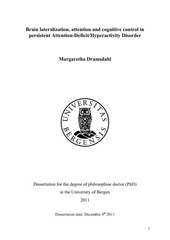| dc.contributor.author | Dramsdahl, Margaretha | en_US |
| dc.date.accessioned | 2012-01-04T15:17:37Z | |
| dc.date.available | 2012-01-04T15:17:37Z | |
| dc.date.issued | 2011-12-09 | eng |
| dc.identifier.isbn | 978-82-308-1894-7 (print version) | en_US |
| dc.identifier.uri | https://hdl.handle.net/1956/5339 | |
| dc.description.abstract | Objective: Divergent brain lateralization and dysfunctional attention and cognitive control may be part of the pathophysiology of ADHD, with the corpus callosum (CC) and the anterior cortex cinguli (ACC) as important structures. Adults with ADHD may represent a more homogenous subgroup of the disorder compared to children. Research of ADHD has mainly included children and adolescents, whereas neuropsychological and neuroimaging studies of adults with ADHD are sparse. In the clinical studies, which are the foundation of this thesis, we aimed to contribute to the knowledge about brain lateralization, attention and cognitive control in a group of adults with persisting ADHD. The specific aims were to compare an adult ADHD group with healthy controls to explore lateralization of auditory processing and the ability to direct attention and exert cognitive control during various instructions of dichotic listening (DL). Further we wanted to measure the micro- and macrostructure of the CC, as well as the glutamate levels in the midfrontal brain region including the ACC. Method: Adults with ADHD and healthy controls were recruited from the Norwegian ADHD biobank and were subjected to DL tests and three modalities of magnetic resonance imaging (MRI). DL is an experimental behavioural task that measures hemispheric specialization of auditory perception, and the DL paradigm with non-forced and forced instructions is presumed to tap into three different levels of cognition: perception, direction of attention and cognitive control. Structural MRI, diffusion tensor imaging (DTI) and magnetic resonance spectroscopy (MRS) were the MRI modalities used in the actual project. Three different articles constitute this thesis. Results in the three papers are from the same sample of 29 adults with clinically diagnosed ADHD. In study I, DL results from the ADHD group were compared with data from a group of 58 controls selected from a DL database. In study II, the results from structural MRI and DTI of the CC were analyzed, and the results from the 29 adults with ADHD were compared to the results from the 37 healthy controls. In study III, we focused on the results from MRS, and compared the measures of glutamate in the midfrontal brain region, including the ACC, from the 29 ADHD participants with the measures from 38 healthy controls. Results: In study I, we found no group differences during non-forced or forced-right conditions of DL, but adults with ADHD were impaired in their ability to report the left-ear syllables during the forced-left instruction condition, whereas the control group showed the expected left-ear advantage in this condition. In study II, we found reduced fractional anisotropy (FA) values which may reflect changes of the microstructure, in the posterior part of the CC in the ADHD group compared to the control group, though the size of the CC did not differ across the groups. In study III, a group difference was found with significant reduction of glutamate/creatine ratio (Glu/Cre) in the left midfrontal region in the ADHD group, as well as a side effect with reduced Glu/Cre in the left compared to the right midfrontal region. Conclusions: Adults with ADHD seem to have a deficit in cognitive control, but not in auditory processing or focus of attention when measured by DL tasks. Normal macroscopic size of the CC and reduced FA values in the posterior callosal part contrast the findings of those in children who seem to have both reduced macro- and microstructure of the CC. Our findings may point to a delayed development of the CC in adults with ADHD, but not to a total normalization. The reduced microstructure may reflect impaired interhemispheric connectivity in the posterior part of the CC. The reduction of Glu/Cre in the left midfrontal region in the ADHD group may reflect a cortical glutamatergic deficit. Glutamatergic deficit in the ACC may result in problems with cognitive control and possibly cause a defect thalamic filter-function, which may in turn result in overload of stimuli to the cortex, although this is a speculative hypothesis. A glutamatergic deficit may be a result of epigenetic factors, and a glutamatergic disturbance during maturation of the brain may have an impact on the cerebral development, which could explain the diversity of brain abnormalities revealed in ADHD research. Lastly, a glutamatergic dysfunction may cause an imbalance in other transmitter systems such as the dopaminergic circuitry. | en_US |
| dc.language.iso | eng | eng |
| dc.publisher | The University of Bergen | eng |
| dc.relation.haspart | Paper I: Dramsdahl M., Westerhausen R., Haavik J., Hugdahl K., Plessen K.J. Cognitive control in adults with attention-deficit/hyperactivity disorder. Psychiatry Research 3(15): 406-410, August 2011. Full text not available in BORA due to publisher restrictions. The article is available at: <a href="http://dx.doi.org/10.1016/j.psychres.2011.04.014" target="blank"> http://dx.doi.org/10.1016/j.psychres.2011.04.014</a> | en_US |
| dc.relation.haspart | Paper II: Dramsdahl M., Westerhausen R., Haavik J., Hugdahl K., Plessen K.J. Adults with ADHD - a diffusion-tensor imaging study of the corpus callosum. Psychiatry Research: Neuroimaging. Full text not available in BORA due to publisher restrictions. | en_US |
| dc.relation.haspart | Paper III: Dramsdahl M., Ersland L., Plessen K.J., Haavik J., Hugdahl K., Specht K. Adults with attention-deficit/hyperactivity disorder - a brain magnetic resonance spectroscopy study. Frontiers in Psychiatry 2:65, July 2011. The article is available at: <a href="http://hdl.handle.net/1956/5338" target="blank">http://hdl.handle.net/1956/5338</a> | en_US |
| dc.title | Brain lateralization, attention and cognitive control in presistent Attention-Deficit/Hyperactivity Disorder | en_US |
| dc.type | Doctoral thesis | |
| dc.rights.holder | Copyright the author. All rights reserved | |
| dc.subject.nsi | VDP::Social science: 200::Psychology: 260::Biological psychology: 261 | eng |
